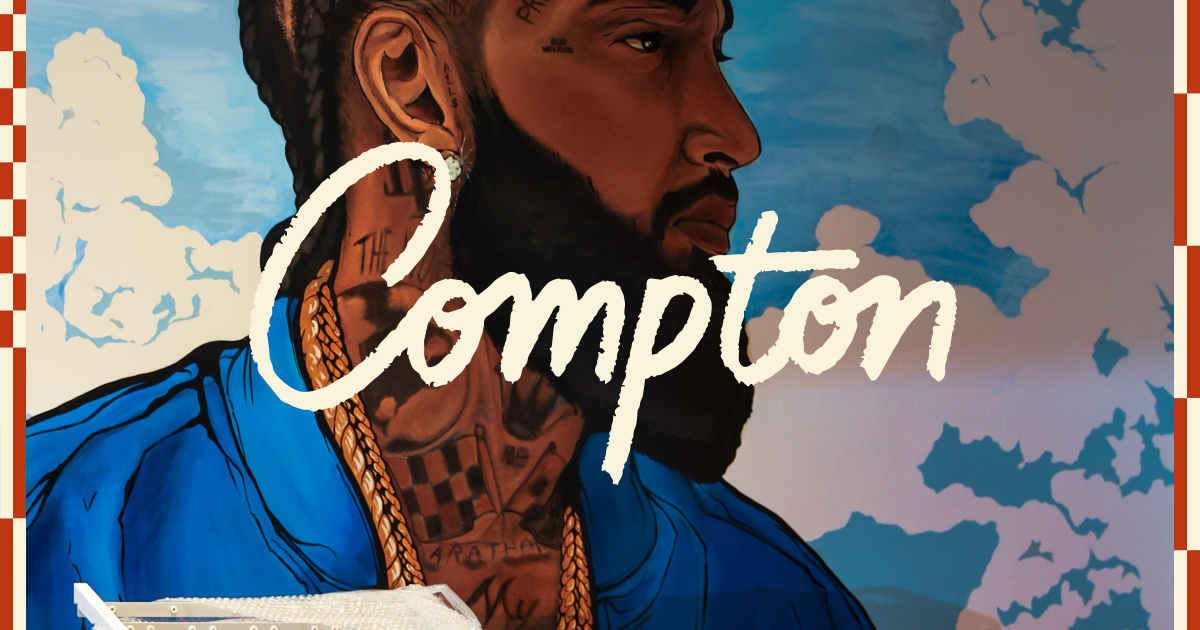In Kendrick Lamar’s star-studded music video for “Not Like Us” — a diss record aimed at Canadian rapper Drake — hundreds of fans are standing around the Pulitzer Prize and Grammy winner near Compton City Hall.
As the lively crowd turns up and dances, they rap along to the infectious chorus.
“They not like us, they not like us, they not like us.”
It’s a strong sentiment that goes far beyond the rap beef or hip-hop in general. Rather, it perfectly highlights the spirit of Compton and its people: Despite characterizations of violence in pop culture portrayals, the residents of Compton shake off those misconceptions and rep their city with pride.
“Compton’s always been the future for me,” Lamar said during his unexpected appearance at Compton College’s commencement ceremony in June, about a month before the momentous video shoot. The Compton native has long made the city a focal point in his music and visual iconography. “I think we breed some of the most incredible individuals, creators, intellectuals. … I’ve traveled the world, there’s no place like this one right here.”
For decades, Compton has given the world icons and change-makers like mogul Dr. Dre, tennis greats Serena and Venus Williams and actor Anthony Anderson.
Located southeast of Los Angeles, Compton is known as “Hub City” because it’s located almost exactly in the center of Los Angeles County. The city was incorporated in 1888 — the eighth to do so in the county. Prior to the 1950s, Compton was predominantly white even as Black families moved to Los Angeles from the South, both to escape Jim Crow and in search of good manufacturing jobs. Racially restrictive housing covenants banned Black and other nonwhite families from living in desirable neighborhoods and suburbs like Compton. Then in the 1960s, the U.S. Supreme Court ruled that the covenants were illegal. Black families moved into Compton and white residents fled. Now, the city is largely Latino.
Home to nearly 100,000 residents, Compton is filled with history. Compton City Hall and Civic Center, which features a stunning memorial for Martin Luther King Jr. in the center of the plaza, was designed by artist Gerald Gladstone in collaboration with Harold L. Williams, a prolific Black architect who apprenticed under Paul R. Williams (known for designing buildings like the Los Angeles County Courthouse and the Beverly Hills Hotel’s Crescent Wing). Less than one mile from the 91 Freeway and the city’s downtown is the Richland Farms neighborhood, a deep-rooted oasis for Black equestrians since the mid-20th century and home to the beloved Compton Cowboys. Visitors can drive down “Eazy Street,” which was originally called Auto Drive South but was renamed in 2023 to honor late rapper and Compton native Eazy-E, who helped put the city on the map with his classic single “Boyz N the Hood.” Head over to East Rancho Dominguez Park to see where tennis greats Venus and Serena Williams honed their skills.
But the image many people have of Compton is the one popularized in the late 1980s and early ’90s. For decades, the midsize city of Compton struggled with an outsize reputation, seared into American pop culture as a place synonymous with gangs, drive-by shootings and gangsta rap. Albums like N.W.A’s “Straight Outta Compton” and headlines during a painful time in American history when the drug epidemic had disproportionately affected Black communities made people cautious about the city.
While certain problems persist, such as economic development, issues with law enforcement and homelessness, the city has made significant strides in recent years, including lowering its crime rates. The transformation is palpable. On Aug. 24, the city is set to host its first Compton Fest, a free event featuring live music performances, panel discussions and workshops, at Compton College. The theme is “Restoring the Pride of Compton.”
Keith Curry, the president and CEO of Compton College, has witnessed the changes in Compton over the years. He recognizes how far his hometown has come.
“I love the community and the people,” he says. “I’m so familiar with it. I know the back streets and how to get through Compton, and so I just feel at home every time.” As a kid, he recalls bouncing around to his friends’ houses in his neighborhood during the summer while his parents were at work. “People on my block took care of me. … They kept me out of trouble.”
Curry adds that he has a “chip on his shoulder” because of how some people view Compton. “I always feel like we’re the underdog,” he says. “It’s always something negative associated with Compton and people don’t talk about the positives — and there’s a lot of positives.”
From local farms to family-owned restaurants, colorful murals, open-mic nights, an energetic running club and more, this must be Compton.
What’s included in this guide
Anyone who’s lived in a major metropolis can tell you that neighborhoods are a tricky thing. They’re eternally malleable and evoke sociological questions around how we place our homes, our neighbors and our communities within a wider tapestry. In the name of neighborly generosity, we included gems that may linger outside of technical parameters. Instead of leaning into stark definitions, we hope to celebrate all of the places that make us love where we live.



